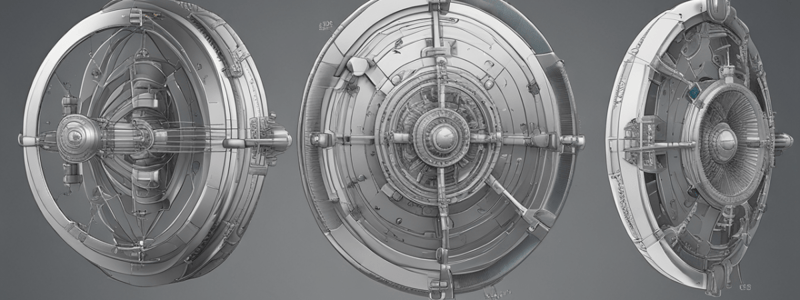Podcast
Questions and Answers
What is the primary purpose of using units?
What is the primary purpose of using units?
- To make calculations simpler
- To compare different physical quantities
- To define fundamental quantities
- To express the numerical value of a physical quantity (correct)
What are the three fundamental physical quantities?
What are the three fundamental physical quantities?
- Time, velocity, and force
- Length, time, and speed
- Length, temperature, and mass
- Length, time, and mass (correct)
How is the length of an object defined?
How is the length of an object defined?
- By calculating the object's mass
- By measuring the object's time
- By determining the object's velocity
- By comparing the object with multiples of some standard length (correct)
What are meters, feet, seconds, and hours examples of?
What are meters, feet, seconds, and hours examples of?
What are units of miles per hour, kilometers per hour, and meters per second examples of?
What are units of miles per hour, kilometers per hour, and meters per second examples of?
What is the purpose of using standard units of time?
What is the purpose of using standard units of time?
What is the unit used to measure the mass of an object?
What is the unit used to measure the mass of an object?
What is the result of converting units?
What is the result of converting units?
What is the primary base unit for measuring time?
What is the primary base unit for measuring time?
What does the prefix 'centi-' represent in a unit?
What does the prefix 'centi-' represent in a unit?
What is the purpose of using conversion factors?
What is the purpose of using conversion factors?
How are units treated in calculations?
How are units treated in calculations?
What is the conversion factor for 1 mile in meters?
What is the conversion factor for 1 mile in meters?
What is the primary unit for a given fundamental quantity?
What is the primary unit for a given fundamental quantity?
What is the purpose of using powers of ten in units?
What is the purpose of using powers of ten in units?
What is the result of carrying units along in a calculation?
What is the result of carrying units along in a calculation?
What is the primary purpose of using units in measurements?
What is the primary purpose of using units in measurements?
When expressing a measurement with uncertainty, what does the ∓ symbol indicate?
When expressing a measurement with uncertainty, what does the ∓ symbol indicate?
Which of the following digits are always significant?
Which of the following digits are always significant?
What is the rule for trailing zeros in a number without a decimal place?
What is the rule for trailing zeros in a number without a decimal place?
When multiplying or dividing numbers with different numbers of significant figures, what is the rule for the final answer?
When multiplying or dividing numbers with different numbers of significant figures, what is the rule for the final answer?
What is the purpose of specifying the uncertainty in a measurement?
What is the purpose of specifying the uncertainty in a measurement?
What is the significance of leading zeros in a number?
What is the significance of leading zeros in a number?
What is the rule for significant figures when adding or subtracting numbers with different numbers of significant figures?
What is the rule for significant figures when adding or subtracting numbers with different numbers of significant figures?
Why is it important to specify the units of a measurement?
Why is it important to specify the units of a measurement?
What is the significance of zeros between non-zero digits in a number?
What is the significance of zeros between non-zero digits in a number?
When measuring a physical quantity, there is always some certainty in the measured value.
When measuring a physical quantity, there is always some certainty in the measured value.
The length of a desk can be expressed as 98.6 ± 0.1 cm, meaning the length is between 98.7 cm and 98.5 cm.
The length of a desk can be expressed as 98.6 ± 0.1 cm, meaning the length is between 98.7 cm and 98.5 cm.
All non-zero digits in a number are significant figures.
All non-zero digits in a number are significant figures.
Leading zeros in a number are always significant.
Leading zeros in a number are always significant.
Trailing zeros in a number are significant if a decimal place is not present.
Trailing zeros in a number are significant if a decimal place is not present.
When multiplying or dividing numbers with different numbers of significant figures, the final answer should be given to a number of significant figures equal to the largest number of significant figures in any of the numbers used in the calculation.
When multiplying or dividing numbers with different numbers of significant figures, the final answer should be given to a number of significant figures equal to the largest number of significant figures in any of the numbers used in the calculation.
Zeros between non-zero digits in a number are never significant.
Zeros between non-zero digits in a number are never significant.
The purpose of using units is to prevent common errors in calculations.
The purpose of using units is to prevent common errors in calculations.
When expressing a measurement with uncertainty, the ± symbol indicates the exact value of the measurement.
When expressing a measurement with uncertainty, the ± symbol indicates the exact value of the measurement.
When measuring a physical quantity, it is not necessary to specify the units of the measurement.
When measuring a physical quantity, it is not necessary to specify the units of the measurement.
What is the significance of specifying the uncertainty in a measurement?
What is the significance of specifying the uncertainty in a measurement?
Which of the following digits are always significant in a number?
Which of the following digits are always significant in a number?
What is the rule for significant figures when multiplying or dividing numbers with different numbers of significant figures?
What is the rule for significant figures when multiplying or dividing numbers with different numbers of significant figures?
What is the significance of trailing zeros in a number with a decimal place?
What is the significance of trailing zeros in a number with a decimal place?
Why is it important to specify the units of a measurement?
Why is it important to specify the units of a measurement?
Flashcards are hidden until you start studying




